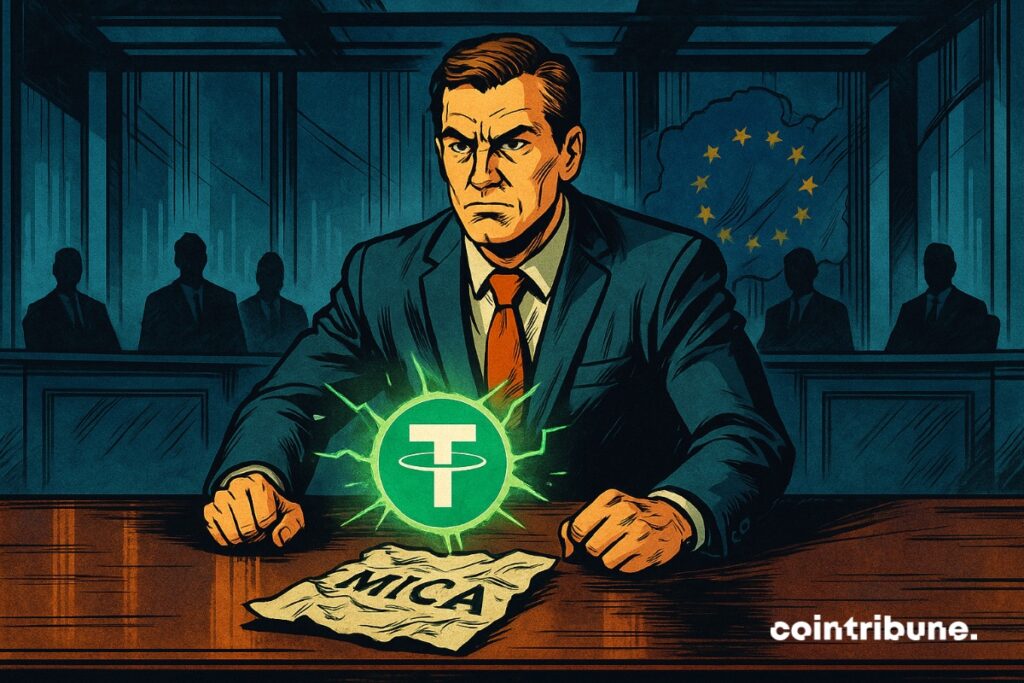Fri 02 May 2025 ▪
3
min read ▪ by
Tether throws a wrench into the European regulatory pond: its CEO categorically refuses to submit USDT to the MiCA framework. A decision that could disrupt the stablecoin market in Europe, weaken crypto exchanges, and highlight a direct clash between regulation and global financial innovation.


In Brief
- Tether’s CEO rejects USDT registration under the European MiCA regulation.
- Tether’s CEO deems MiCA requirements dangerous for banks and contrary to financial freedom.
- The EU sees USDT as a threat to its monetary sovereignty against the dollar.
- Several platforms remove USDT in Europe, reshuffling the stablecoin market.
A Regulatory Framework Too Restrictive for Tether
In a bold move, Tether CEO Paolo Ardoino confirmed that the company will not seek to comply with the MiCA regulation for its USDT stablecoin, despite the new crypto rules coming into effect in Europe. At the Token2049 summit in Dubai, he denounced the framework as “dangerous” for stablecoins, stating it could weaken European banks.
According to the Tether leader, MiCA’s requirements — such as the obligation to place 60% of stablecoin reserves in insured bank deposits within the EU — pose major risks to the European banking system. “I must protect our 400 million users worldwide, not just Europeans,” he declared. He accuses the European Central Bank of using MiCA as leverage to promote the digital euro and restrict citizens’ financial freedom.
Towards Marginalization in Europe?
Europe fears Tether’s growing influence, as behind its stablecoin lies a geopolitical threat: it is backed by the US dollar, reinforcing the greenback’s dominance at the very heart of the eurozone. By allowing USDT to circulate freely, Brussels fears a loss of monetary sovereignty, increased dependence on the United States, and weakening of the digital euro project.
MiCA thus becomes a regulatory barrier to limit the expansion of an asset considered a financial influence weapon. Crypto platforms like Kraken and Binance responded by removing several stablecoins, including USDT, to stay compliant with this regulation. This could curb the use of Tether, the world’s most capitalized stablecoin in Europe, forcing players to turn to other regulated cryptos like Bitcoin or Ethereum.
Tether’s refusal to adopt MiCA illustrates the standoff between European regulation and crypto giants. This decision could disrupt the balance of stablecoins in the EU, deepen the regulatory divide, and push platforms to reconsider their strategies amid a market in deep reconfiguration.
Maximize your Cointribune experience with our “Read to Earn” program! For every article you read, earn points and access exclusive rewards. Sign up now and start earning benefits.
The world is evolving and adaptation is the best weapon to survive in this undulating universe. Originally a crypto community manager, I am interested in anything that is directly or indirectly related to blockchain and its derivatives. To share my experience and promote a field that I am passionate about, nothing is better than writing informative and relaxed articles.
DISCLAIMER
The views, thoughts, and opinions expressed in this article belong solely to the author, and should not be taken as investment advice. Do your own research before taking any investment decisions.

